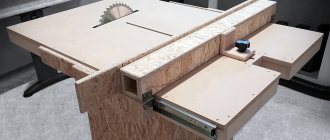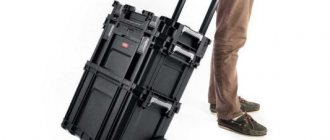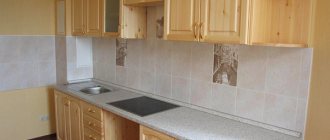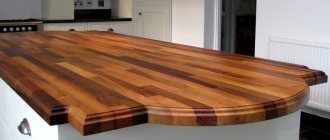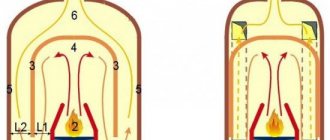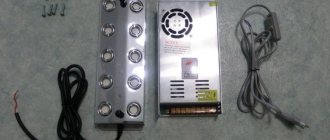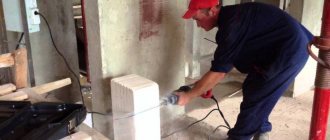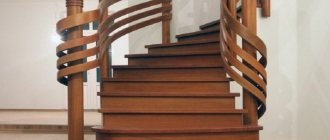When working with a hand-held circular saw, a perfectly even cut can only be achieved using special tools. And you can’t do without them on a stationary machine. One of them is the circular saw guide. Let's look at what types of stops there are and how to make them yourself.
Guide for manual circular saw Source mrherramientas.es
Introduction
The machine consists of three main structural elements:
- base;
- sawing table;
- parallel stop.
The base and the sawing table itself are not very complex structural elements. Their design is obvious and not so complicated. Therefore, in this article we will consider the most complex element - the parallel stop.
So, the rip fence is a moving part of the machine, which is a guide for the workpiece and it is along it that the workpiece moves. Accordingly, the quality of the cut depends on the parallel stop because if the stop is not parallel, then either the workpiece or the saw blade may become jammed.
In addition, the parallel stop of a circular saw must be of a rather rigid structure, since the master makes efforts to press the workpiece against the stop, and if the stop is displaced, this will lead to non-parallelism with the consequences indicated above.
There are various designs of parallel stops depending on the methods of attaching it to the circular table. Here is a table with the characteristics of these options.
| Rip fence design | Advantages and disadvantages |
| Two-point mounting (front and rear) | Advantages: · Quite rigid design, · Allows you to place the stop anywhere on the circular table (to the left or right of the saw blade); · Does not require the massiveness of the guide itself. Disadvantage: · For fastening, the master needs to clamp one end in front of the machine, and also go around the machine and secure the opposite end of the stop. This is very inconvenient when selecting the required position of the stop and with frequent readjustment it is a significant drawback. |
| Single point mounting (front) | Advantages: · Less rigid design than when attaching the stop at two points, · Allows you to place the stop anywhere on the circular table (to the left or right of the saw blade); · To change the position of the stop, it is enough to fix it on one side of the machine, where the master is located during the sawing process. Disadvantage: · The design of the stop must be massive in order to ensure the necessary rigidity of the structure. |
| Fastening in the groove of a circular table | Advantages: · Quick changeover. Disadvantages: · Complexity of design, · Weakening of the circular table structure, · Fixed position from the line of the saw blade, · Quite a complex design for self-production, especially from wood (made only from metal). |
In this article we will examine the option of creating a parallel stop design for a circular saw with one attachment point.
How to choose a saw blade for circular and miter saws
5/5 — (3 votes)
The saw blade has a number of parameters that any user needs to know. First, it must be the perfect size for the specific instrument. Secondly, a whole range of shapes and design of the disk affects what material will have to be processed. Thirdly, do not forget about the many manufacturers on the market offering products of varying quality. All this and more will be discussed further in this article.
It's no secret that properly selected equipment is the key to successful work. Wood and its derivatives are very popular materials in our country. Therefore, the area of use of the saw blade is quite wide, both in a professional environment and in the domestic sphere.
The saw blade is the main attachment for the following tools:
- Circular (circular) saws;
- Miter saws;
- Woodworking machinery.
The main criteria for selecting a disk are its size ratio with a specific tool and the material that needs to be cut with this disk. Let's look at the criteria in more detail.
The saw blade has a dimension. |
In order to choose the right saw blade, you must know its internal (landing) and external diameter.
The outer diameter ( D ) of the disk directly affects the depth of cut and has certain maximum size parameters (65-500 mm), limited by the casing and design of the tool. It is permissible to install a blade on the saw with an outer diameter slightly smaller than the factory standard (by 5-10 mm). At the same time, the depth of cut will decrease slightly (2.5-5 mm, respectively).
The seat diameter ( d ) of the disk must ideally coincide with the diameter of the circular saw shaft (10-50 mm) on which it is installed; even the slightest play is unacceptable. It is possible to adjust an internal diameter of a disk that is too large using special adapter washers (example in the figure below). They are often supplied with a new drive.
The thickness (T) of the saw blade can vary from 0.7 to 4 mm and determines the thickness of the seam when cutting. Of course, the larger the outer diameter of the disk, the higher the minimum permissible thickness will be. A thin disk will cut faster and process the material more economically, while a thick disk will be more durable and durable.
As the outer diameter increases, the number of revolutions for which the saw blade is designed decreases. You need to select a disk so that its maximum speed exceeds by a margin the maximum speed on the output spindle of the tool where the saw set is installed.
Under no circumstances should you attempt to install saw blades for circular and miter saws on angle grinders (angle grinders), even if the mounting diameter is suitable. They are designed for a certain number of revolutions when used. As a rule, it is less than what a high-speed angle grinder produces. This is fraught with the risk of the saw blade flying apart during the sawing process, which is very dangerous.
The design of the cutting elements of the saw blade. |
This criterion is more extensive and includes such structural elements of the disk as the type of disk, the number of teeth and their shape.
All saw blades are divided into two main types : monolithic and carbide.
Monolithic saw blade
is the original type, which is not very popular now, but is still found on the market. It consists of a solid metal base of the body and teeth made of high-carbon (higher quality) or high-speed steel. The disc teeth are set and sharp, which must be constantly maintained. It must be said that they become dull very quickly, and sharpening them is very difficult. This is precisely the reason for the unpopularity of this type.
Types of teeth of a monolithic disk:
- Sharp teeth - suitable for cutting hard and soft wood, clean longitudinal and transverse cuts.
- Curved teeth - used for working with soft wood and simple cutting, have a wide back.
Carbide saw blade
has a disk body consisting of tool steel and reinforced soldering on each tooth. Soldering, in turn, can be made from cobalt, tungsten carbides, and artificial diamond. Thanks to this design, such disks are very popular, as they have many advantages:
- Very durable and strong, soldered teeth dull very slowly.
- High cutting speed, and the quality of the cut does not decrease, but on the contrary - cleaner and more accurate.
- More versatile and allow you to cut many materials (wood and its derivatives, plastic, laminate, metal tiles).
- Huge selection on the market.
The only disadvantage we can note is the difficulty of sharpening the solder tips, which requires specialized equipment. In addition, soldering tends to fly off over time, which depends on the quality of their factory soldering to the disk body. But you can use the disc even if you lose 20% of the teeth, the main thing is that they are not located in a row.
What does the number of teeth on a saw blade affect?
The frequency of the teeth is related to the shape of the teeth and the sharpening of the tips. It is better to consider these elements together and identify several main types of saw blades depending on what material needs to be cut and what quality of cut is needed. Let's consider three main types of configuration:
Saw blade for wood and its derivatives (plywood, chipboard) with a positive tooth angle (a). Has high cutting speed and better performance. Alternating one-sided sharpening of teeth (A and B) is suitable for rapid longitudinal and transverse cutting of wooden workpieces.
20-24 teeth – a small number of teeth expels sawdust well and is more suitable for soft wood. An aggressive cut cuts faster, although not very cleanly.
36-48 teeth – a medium number of teeth will do a better job of cutting hardwood, plywood and chipboard. The cut will be cleaner than the previous version.
Saw blade for laminate and other materials with a laminated surface. Such discs are more often found with a positive sharpening angle, but they are also found with a negative one for working with thin workpieces. Trapezoid-shaped teeth perform dirty sawing (A), and straight teeth (B) at a lower height finalize the cleanliness of the edge.
40-64 teeth – frequent tooth arrangement, allowing use with laminated delicate materials. A good quality cut will take place slower than usual, with additional load on the tool.
Saw blades for aluminum and metal profiles have a negative tooth angle (a). Trapezoid-shaped teeth perform dirty sawing (A), and straight teeth (B) at a lower height finalize the cleanliness of the edge. As a rule, such discs are thicker or made of higher quality material, as they must withstand additional lateral load.
80-120 teeth – a large number of teeth provides the cleanest cut, smoothest edges and is suitable for working with thin materials. Theoretically, such a disk will be suitable for working with wood materials, and the cut will be of very high quality, but the work speed will be low and the load on the tool will be high.
Tooth shape
The saw blade plays a huge role in the quality of the cut. You can see a huge variety in this component. Many manufacturers improve the characteristics of the blade precisely by improving the shape of the tooth, so carefully study the purpose of a particular saw blade. Let's look at common discs depending on their tooth shape:
- Fine tooth blade with feed limiter at the end for longitudinal cutting of the hardest types of wood.
- Grooving saw blade for cutting blind grooves, as well as profiling and quartering for soft and hard wood, chipboard and plastic.
- The tapered scoring disc allows you to vary the groove thickness by increasing or decreasing the feed height in lightweight materials.
- Saw blade with almost flat, elongated teeth for cutting sheet metal, sandwich panels, metal pipes, etc.
- Diamond-tipped saw blades for angle grinders for sawing wood, metal, plastic and concrete. There are many types, you should be careful when purchasing data and choose only high-quality and trusted manufacturers.
Of course, these are not all types of tipped saw blades, but they are the most commonly used. If there is difficulty when purchasing and understanding what configuration a disk is required, then the manufacturer indicates all its data and purpose on the factory packaging.
The saw blade may have compensation and sometimes damping slots in its design, which significantly reduce its heating during operation, reduce vibration and noise. The slots are made in the form of grooves extending from the top edge to the center, with thickening or rounding towards the end to reduce the dynamic pressure on the disk body, which further increases its strength.
A little about the manufacturers - which saw blade is of better quality |
Beware of counterfeits or low-quality saw blades, these are unsafe. So, if the quality does not inspire confidence, it is better to refuse the purchase. Keep in mind that a good disc cannot be cheap. The data on the body itself of high-quality specimens is laser engraved and may even contain a barcode, rather than painted with regular paint or made in the form of a sticker.
Each manufacturer has its own way of designating the quality gradation on its saw set. For example, in the form of several quality series: master, pro and expert; number of icons - stars on the packaging of the standard, expert, etc. series. from Bosch.
The “low” series uses simpler steel, while the high series uses high-carbon steel of better quality. The brazing on the teeth can also be made of carbide or stronger diamond plates. Solders are attached to the disk body by thermal crimping or laser spot welding. Any quality addition will add to the cost of the product. Because of this, the “high” series are often an order of magnitude more expensive, but they will last much longer and their reviews are mostly positive.
| Site rating: prof. manufacturers | ||
| 1. | Bosch | They have exclusively positive user reviews. A huge range of quality, size and disc accessories. |
| 2. | CMT | Simply excellent wheels, no worse in quality than Bosch. Not in first place only because of the very high price and so far poor distribution in our market |
| 3. | DeWalt | Professionals also praise these discs; they are especially pleased with the Extreme series, which is not afraid of either hard wood or nails in it. |
| Site rating: budget manufacturers | ||
| 1. | Attack | The Korean company has long proven its products, which are often purchased even by professionals |
| 2. | Practice | The best price-quality ratio, a huge range of sizes from different series. |
| 3. | Bison | Another pretty good saw blades at an affordable price. |
If for some reason you cannot determine the size of the blade for a circular or miter saw, then you can select it by company and specific model of the tool in a separate article on our website.
| ¦¦ THIS IS INTERESTING ¦¦ |
|
Conclusion. |
The first thing you need to pay attention to when selecting a saw blade is its exact size. Having decided on the material that needs to be processed, the optimal disk design, number and shape of teeth will become clear. A correctly selected blade will cut faster and cleaner, plus there will be less load on the tool’s engine. And of course, don’t forget about quality and safety! We strongly advise against purchasing saw blades of dubious quality or using them for other purposes.
Have a good job!
4.2 12 votes
Article rating
Useful tricks and tips
There are such small devices that it is shameful to even consider them a tool. At the same time, they are great for cutting. These are the tricks of experienced masters.
Blank template
When cutting a large number of identical parts, you can use the first of them as a template for cutting subsequent copies. You just need to fasten a thrust piece on one side of the first sample with a width corresponding to the distance from the edge of the slab to the cutting disc. By installing such a template on the material to be cut, you can make many identical parts without markings.
Installation bars
The simplest part that makes it easier to install any stop and guide along the markings is a small cross-section block. There are cuts on it, the distance between which is equal to the segment from the end of the saw sole to the saw blade. Two such bars will help you install any guides quickly and accurately at the required distance from the marking line. All that remains is to secure the guide.
Pull-out protection
The protection can be any block whose width corresponds to the thickness of the workpiece being cut. If it is secured at the point where the saw blade exits the material being processed, it will act as a limiter and serve as protection against tearing out and chipping.
These devices are not limited to the range of useful homemade products that make working with a hand-held circular saw easier. These are the easiest to make. Others require time and skill. But craftsmen even make such a device as a protractor for a circular saw with their own hands. There would be a desire.
Other types
If for some reason the plywood rail does not meet your requirements, you can make the guide of a more complex design. Below are a few more examples of guides for a manual circular saw that anyone can make with their own hands.
Aluminum profile tire
This type of tire differs from a simple plywood tire in that a U-shaped aluminum profile is installed in the guide gap. Its advantage is that the rigidity of aluminum slightly increases the cutting accuracy.
For better sliding of the saw along the bar, as limiters, you can attach not thick plywood to the guide groove of the sole, but a pair of cylinders of suitable height made of fluoroplastic or other material with a low coefficient of friction.
Ruler from a building code
There are long aluminum rules that are used by finishers to level walls. To make a guide ruler with your own hands, rules are suitable, the design of which provides a groove for the free movement of the handles.
The main advantage of such a line is the absence of elements protruding above the surface of the workbench. To do this, you need to take two collapsible clamps and slightly modernize them.
The handles are removed from the rule, and their upper parts from the clamps, which are replaced with polypropylene or fluoroplastic inserts. The profile of these inserts must be T-shaped so that they can be installed with the wide part into the rule groove and be held there.
The result is a ruler that is attached to the workbench only at the bottom. This will allow you to move the saw freely in the work area without fear of getting caught on something.
However, such a tool cannot be called a full-fledged tire. This is the ruler that needs to be adjusted before each cut.
Rail miter box
This device is most often used for cross cutting (trimming) of material.
Usually it consists of two parallel metal corners, the ends of which are rigidly fixed to a plywood or metal base.
The saw platform moves freely along the corners, as if on rails.
The corners are secured with bolts or studs, which are also used to adjust the height of the “rails” relative to the base. The height should be such that the material to be cut fits freely under the corners.
To make the saw movement smoother, the corners on the inside can be glued with a material with a high slip coefficient. For even smoother movement, you can install the saw sole on a platform with metal wheels.
External carriage on bearings
A circular saw on an external carriage is more like a stationary format-cutting machine. This design is highly stable and, accordingly, provides high cutting accuracy.
The remote carriage is made of a metal I-beam, which is firmly attached with its lower plane to the workbench. The carriage itself moves along the upper plane - a platform, the lower edges of which are bent inside the I-beam and are equipped with bearings that allow it to slide freely. These same bearings, tightly pressed to the I-beam axis, eliminate lateral play of the carriage.
The saw sole is attached parallel to the carriage on the external guide. The guide can be made of two parallel angles or pipes - thus, by moving the sole of the saw, you can adjust the size of the cut of the material.
This design is good because the saw support platform is adjacent directly to the workpiece, which means the cutting depth is not reduced.
How to make it yourself
If we take as a basis the design of a device for self-production from the Internet, then a guide for a circular saw can be assembled with your own hands from available materials - an aluminum profile, a building code or a regular laminate.
The simplest and most convenient guide option is a ruler made of aluminum profile or laminate. The aluminum profile has great rigidity, it does not bend and is easy to fix on different surfaces. To move the circular saw, you can use it as a stop, fixing it with clamps on the workpiece. When working, it is enough to press the circular saw tightly against it to get the correct, even cut. If you use grooves in an aluminum profile as guides, you need to equip the sole with two pins that will fit into the groove and prevent the tool from moving to the side when moving.
The rule makes the bus more functional. If the profile has a large cross-section, then the construction rule has a flat shape, this makes it easier to handle. And such a ruler can be made with your own hands much faster. You can use ordinary carpentry clamps as clamps, and you can attach a steel ruler with a scale to the guide profile itself. Just like with an aluminum profile, the rule can be used both as a stop for a circular saw and as a rail guide. For better sliding, you can adapt a hard plastic plate of the required thickness, so that the sole is parallel to the plane of the workpiece. The groove in the rule profile will be used as a guide in this design. It is along it that the stops fixed on the sole of the circular saw will move. Small pieces of plastic fixed with bolts can be used as stops. They are inserted into the groove, and the circular moves strictly along this guide.
Another affordable option for a table saw guide on a budget would be a piece of laminate. Such a tire, in contrast to the rule and profile, will be small, but for its manufacture only two planks of material and a U-shaped aluminum profile are enough. Laminate, unlike other materials, is compressed cellulose, which is not subject to warping like natural wood or plywood. This makes it possible to obtain a light, durable and, most importantly, even guide bar for working with a circular saw. To do this, it is enough to dissolve one plank along the length into equal parts. After this, strictly in the middle of the whole section of the laminate, you need to screw the U-shaped profile with self-tapping screws. After this, attach the profile halves to the bar on both sides and process the edges of the resulting tire.
The circular, as in the case of the rule, will move along the surface of the tire. You can maintain the direction using plastic protrusions attached to the sole.
Making a tire with your own hands
The main task is to make a geometrically accurate product with your own hands, which is not easy. I would like to make a convenient and reliable device, spending a minimum of time.
Option 1
The guide rail is made of laminate - the simplest and most affordable material.
- We cut two pieces of laminate of the same length along a ruler (for example, 50 cm).
- We mill one edge at a time.
- We attach it with self-tapping screws to the base, also made of laminate.
- The width of the groove is checked using a sheet of A4 paper, approximately 0.11 mm thick: the paper is inserted into the device and screwed.
- The guide is fixed to the sole of the circular saw with your own hands through the mount for the side stop. You can drill a special hole in the case, if you don’t mind and the warranty period has passed.
- When working with the guide bar, it should be extended as far as possible in front of the hand-held circular saw. And the nose of the sole should extend a few centimeters onto the guide. Now let’s take a disk for sawing laminate and saw off the edges of the guides on the spot so that they align perfectly with the markings;
This device eats up the cutting depth a little (by about 1.5 cm), but it is very convenient and easy to do with your own hands.
Option 2
Now let's take the construction rule as the basis for the tire. A model with handles that move along a groove is suitable.
- We remove the handles and instead select soft-locking clamps with spring handles. There are models with a removable top - they are just right. Having removed it, the clamp is fixed to the rule using an adapter.
- The adapters will have to be made yourself from polypropylene on a milling machine. As a result, you should get parts that resemble the letter “T” in cross-section; they are tightly inserted into the groove for the handles.
- We make holes in the “leg” of the adapters and screw clamps onto the screws.
- The guide is placed on a sheet of material with the groove down and securely pressed with clamps from below. There is not a single part on top that slows down the operation of the circular saw. There is only one limitation in the work - the length of the rule, so you need to take the longest one.
Option 3
To obtain an accurate cut with a circular saw, one important condition is necessary: the edge of the base of the tool, which is adjacent to the guide, must be perfectly smooth. Professional units with cast soles have this property by definition
The same cannot be said about inexpensive stamped bases. Therefore, we offer another guide option - rail
Professional units with cast soles have this property by definition. The same cannot be said about inexpensive stamped bases. Therefore, we offer another guide option - a rail.
The tool will move along it without resting against the guide rail. At the same time, significantly reducing the force required to push the hand saw.
An aluminum U-shaped profile is suitable for the rails. Two pieces of different sections are required. The smaller profile should be inserted into the larger one without a gap, but move freely.
Now you can assemble the guide rail with your own hands:
- We take plywood No. 3 and attach a larger diameter guide with screws. We grind off the heads of the screws and screws to hide them flush.
- We place the guide tightly on both sides along a strip of plywood No. 10 and also fasten it with self-tapping screws. Instead of plywood, you can use chipboard.
We saw off the excess pieces to the width and the rail is ready for use.
Now you should prepare your hand saw:
- We insert the small profile into the rail and remove the height of the “legs” so that it fits flush.
- We fix the cut profile to the saw sole parallel to the saw blade. To do this, we use a pair of M4 wing screws. If the disk tool platform is of high quality and level, you can stick to its edge.
- We place the hand saw on the guide, inserting the profile into the guide rail, turn on the saw and saw off the excess strip in width.
- Now, for a perfect cut, you need to place the edge of the tire on the marking and attach the guide with clamps. The main feature of the design is the rails. When using such a guide, the saw moves smoothly, does not wobble, feeds easily and cuts very accurately.
Videos show factory and homemade guide bars:
Making your own guide from plywood is the most popular option.
For a craftsman who constantly performs work on sawing wood, for example, for a furniture maker, the constant use of a tire is strictly necessary. The quality and speed of production depends on this. Experienced users and craftsmen rarely use factory-made products for cutting; more often they make them themselves.
The prerequisites for making a tire yourself are:
- Desire to save money.
- The need to introduce additions to the design that allow more efficient and multifunctional wood processing.
Necessary materials
To produce a tire from wood you will need the following materials:
- Plywood blanks with a thickness of at least 10 millimeters, the length is chosen arbitrarily according to the length of the future cut, the recommended length is 1.2 meters;
- Wooden blocks 30 x 30 mm.
- Metal strips 3-4 mm high, 8-12 mm wide, the length should be equal to the length of the sole on the circular - 2 pcs.
- Fastening elements – hardware, self-tapping screws.
- Fraser.
- Jigsaw.
- Drill with a drill bit with a diameter of 10 mm.
- Screwdriver with a bit for self-tapping screws.
- Clamps.
Step-by-step instructions for making a plywood guide
It is very important to be careful in manufacturing and adhere to dimensions, since any inaccuracy or violation of the straightness of the structure will lead to a serious deterioration in the final result, and consequently to a deterioration in the quality of the cut.
Step-by-step instruction:
- We transfer the size of the saw to the plywood and mark it.
- In order for everything to turn out smooth and beautiful, you need to use something hard and smooth; a piece of profile pipe, a square, or a guide for gypsum boards is suitable for this purpose. We fasten it with clamps at the received mark.
- We retreat 5 cm and make a cut with a router. The height and width of the cut should be the same as those of previously prepared metal plates.
- We retreat another 5 cm, mark and make another cut with a router. To obtain a straight line, we also set the metal profile as a stop.
- We attach the metal guides to the circular saw. The main thing is to do it very smoothly. The protruding parts, beyond the edges of the sole, should be sawed off. It is recommended to grind and polish the working surface, this will make it slide better. And lubricate the grooves in the plywood with wax, this will also give better glide.
- We attach wooden blocks along the edges with glue, and then also tighten them with self-tapping screws.
- For better gliding, cover the working surface of the tire with metal tape. It is very resistant to abrasion.
- That's all, the parallel stop is ready for work.
Another popular material with which you can quickly and easily make a guide for a circular saw is laminate. To do this, we suggest watching a video, the author of which tells and shows in a few minutes how to make a parallel stop from 2 laminate boards in detail, it is very interesting and useful. We recommend.
Adjusting a homemade device
Before starting work, it is necessary to make an adjustment, which consists of selecting the cutting location, as well as the depth of the cut and its length.
There are several useful tips during the adjustment process:
- The device must be positioned evenly in relation to the edges of the material. Distortions are not allowed. To check the straightness of the disk, it is lowered into the cut of the guide.
- After adjusting the tire and disk for straightness, the entire structure is secured with clamps. In some cases, it can be secured to hardware, for which special holes are made in the corners of the tire.
The tire allows you to make cuts at 45 degrees and chamfer edges, but to do this you need to adjust the angle of the circular saw blade.
Work and safety precautions
Since the circular saw itself is considered a very dangerous tool, the improper use of which can lead to serious injury, it is necessary to follow the following safety recommendations:
- When working, you must use PPE - goggles and gloves. It is also prohibited to start working with hanging items of clothing, for example, with unbuttoned sleeves.
- The circular saw starts only after the blade is placed in the guide, but without touching the surface to be processed.
- The tire must be firmly fixed with clamps, since otherwise the kinetic energy of rotation of the saw blade will be transferred to the tire, and it will “fly out”.
- All cuts must be done away from you, and the master himself must stand somewhat to the side, and not in front of the saw.
Making a laminate tire
This method of making a carriage for a circular saw with your own hands is the easiest to implement; it uses readily available raw materials.
Required:
- laminate sheet;
- several screws;
- A4 piece of paper.
Three blanks are made from the laminate. One of them will serve as the basis for the guide. The other two are cut in the shape of two strips, each about half a meter long. For both, the edges are aligned on one side using a milling cutter. Using self-tapping screws, the strips are attached to each other parallel to the straight edges. The width of the groove between them is checked using an A4 piece of paper, inserting it into the device and scrolling.
The tire is secured to the base of the circular saw using side support fasteners. If the warranty period of the saw has already expired, for greater reliability of fastening you can use the body of the circular saw by making an additional hole in it.
Before starting work, the homemade guide must be extended in front of the circular saw handle. In this case, it is necessary that the guide is covered by the nose of the sole by several centimeters. For perfect compatibility of the edges of the guide strips with the marks on the material, you need to carefully saw off the uneven strips with a laminate cutting disc.
Homemade devices
Making a circular saw is not that difficult; problems may arise when fitting the components. Choosing all the elements correctly so that they work flawlessly is an important task. The shaft must have self-adjusting bearings if the unit is used daily. It is best to select the bearings themselves with two rows of balls, which will be adjusted using a clamping nut.
The working surface must have a “grid” marking. Without this coordinate system, accurate woodworking is quite difficult. The protective casing must not be neglected - during operation it reliably protects the device from mechanical damage. A circular saw operates in different modes when working with different materials, so it is advisable to have a device that controls such a process. Several grooves should be made on the shaft so that it is possible to rearrange the pulleys, thus changing the speed.
When you have to saw bars or make several cuts from different directions, you need a stop that has a “P” configuration. At its base lies a board 30 mm thick. Sidewalls 12 mm thick are screwed to the base. Thus, the emphasis is installed on a beam, the size of which from the cutting point corresponds to the size of the cutting disc. On both sides it is pressed against the beam with clamps. If the beam is too massive, then it is rearranged and another cut is made.
There is also an edge stop that is in demand. To make it requires a lot of time and good qualifications of the craftsman. Be sure to make a diagram before starting work. This stop is made from plywood (20 mm), and the stop strip is also made from this material. Manufacturing phases:
- longitudinal grooves for keys are cut;
- the keys are mounted on a thrust strip;
- Another groove is cut between the grooves made to secure the thrust strip;
- another hole is made in the base, its size corresponds to the saw blade of a circular saw;
Sidewalls-limiters are mounted, and there must be clamps in order to securely fasten them. To place the emphasis on the workpiece, the bar moves in the grooves and is fixed through the slot with clamps. It is best to immediately attach a ruler or tape measure to the frame - this makes the work much easier. The pusher is convenient for working with small workpieces - it allows you to fasten the part on both sides, which ensures precision in work
It is also important to do:
- elevator;
- riving knife;
- lifting mechanism.
Capacitors are calculated according to the following scheme: per 1000 watts there are 100 uF for a working type capacitor. The capacity of the starting capacitor must be ordered twice as large. It should be remembered that the SB starting block is a device that automatically returns to its original position. This is very convenient, since literally a few seconds after the start you can begin the workflow.
Useful tips
There are devices that cannot be called a tool, but they still help the master when cutting.
Blank template
When cutting a large number of identical parts, you can use the first one as a template for cutting the rest. You only need to attach a stop piece to one side of the first sample, and when installing such a template on the material to be cut, you can make many identical parts without marking.
Bruschi
This part makes it easier to install any stop and tire according to the markings - a beam with a small cross-section. There should be cuts on it, and the distance between them will be equal to the segment from the end of the saw blade to the disk. A couple of these bars will help you quickly install any guides quickly and easily.
Pull-out protection
The protection can be a block whose width corresponds to the thickness of the workpiece being cut, and if you attach it at the exit point of the disk, it will serve as a limiter and will serve as protection against chipping and tearing out.
From plywood
Necessary materials
To make such a tire you will need three pieces of plywood 10 mm thick. Their length should be the same and is usually equal to the length of the workbench on which the work will be done. One of the segments should be 25-35 cm wide (it will serve as the base), the width of the other two will be determined during the manufacture of the tire. Also prepare 16 mm wood screws.
Drawing with dimensions:
Manufacturing instructions
When creating a guide, all dimensions must be observed very accurately. Small deviations can lead to a sharp deterioration in the result. If desired, laminate can be used instead of plywood.
The plywood guide rail is made in several steps:
- Measure the distance from the inner edge of the saw blade to the rip guide groove located on the tool support platform.
- Cut one of the plywood strips so that its width is 0.2-0.5 mm less than the distance obtained in step 1. The grains of the top layer of veneer on plywood should be directed longitudinally.
- Using self-tapping screws, screw the resulting strip to a wide piece of plywood (base), precisely aligning their ends. This will be the working edge of the tire.
- Using a caliper, measure the width of the longitudinal cut guide groove.
- Screw the remaining strip of plywood to the base parallel to the first strip. There should be a gap between them, the size of which should be 0.2-0.5 mm less than the width of the groove measured in the previous paragraph.
- To avoid damaging the material being cut, a layer of soft fabric is glued to the finished guide on the bottom side.
The homemade guide is ready, all that remains is to prepare the hand saw. To do this, saw off a narrow strip of thick plywood or other sufficiently durable material. The height of this strip should be 8-9 mm greater than the depth of the guide groove on the saw base. The width corresponds to the width of this groove. The length is several centimeters longer than the length of the sole.
The resulting limiter strip should be secured in the guide groove so that it protrudes beyond both edges of the sole.
How to use plywood tire?
To make a cut, you will need two clamps and two flat pieces of wood slightly thicker than the work piece. The guide rail is installed with its ends on these bars so that its working edge protrudes slightly beyond the edge of the workbench table top. In places where the tire rests on the bars, it is tightly fastened with clamps to the workbench.
The workpiece to be cut with a cutting line pre-marked with a pencil is placed under the tire, and the cutting line is aligned with its working edge. Finally, a circular piece with a limit strip attached to it is installed on the tire so that the limiter on the sole fits exactly into the prepared gap. Now you can saw, holding the workpiece with your free hand and lightly pressing the saw towards the workbench.
Operation of plywood tire
In addition to the guide, preparation of the saw for work is required. You need to saw off durable material with dimensions:
- height exceeding the depth of the groove;
- equal in width;
- longer than the sole.
Fastening is carried out with the restriction protruding from under the edges of the sole. To carry out the work, you need to take 2 clamps with two flat bars, but larger in thickness than the part prepared for processing. The ends of the tire are installed on the limiter so that they protrude beyond the tabletop. In areas of contact with wooden blocks, the guide is attached to the base of the table.
On the workpiece to be cut, markings are made along the cutting line. It is placed under the guide, the cutting direction and the working edge are aligned. A circular saw with a fixed limit strip is placed on the guide in such a position that the stop on the sole is aligned with the prepared gap. They saw the part, slightly guiding the part, and at the same time press the tool.
The design has proven in practice the high stability of a high-quality cut. For production, a metal I-beam is taken, which is attached to the lower plane of the workbench. The platform moves along the surface on bearings with the lower edges curved into a profile. The outrigger carriage slides freely thanks to bearings, which, due to tight pressing, relieve the structure from lateral play. The extension guide is held by the sole of the cutting tool.
Parallel angles and pipes are used to make a tire. When the sole moves, the cut is adjusted to size. Thanks to the support platform, which fits tightly to the workpiece, the stability of the cutting depth is not compromised.
The manufacturer of circular saw bars must take into account the working conditions, where the rules of use must comply with:
- the mode of use of the saw - the more often the tool is used, the stronger the raw materials for making the guide should be;
- processing parameters - you need to make sure that the disk completely cuts the thickness of the workpiece;
- technical capabilities of the mechanism.
In addition to the guide, quality cutting is affected by:
- condition of the saw and discs;
- position of the support platform.
Blunt disc teeth leave chips on the material. Tires significantly expand the functions of a circular saw, but poor care of the tool nullifies all the capabilities provided by the manufacturer.
Summary
Article Name
Guide bar for circular saw
Description
DIY guide bar for a circular saw
Author
Sarychev Alexander Viktorovich - forensic construction and technical expert, candidate of technical sciences
Publisher Name
Wikipedia of construction tools
Publisher Logo
- Related Posts
- Electric chain saws - rating
- Reciprocating Saw Rating
- Rating of sawing machines
« Previous entry
Applications of Circulating Hand Saws
A hand-held circular saw belongs to the category of hand tools.
Diagram of a circular saw.
The required power and saw blade diameters depend on this parameter. According to the cutting depth, the tool is usually divided into categories:
- Up to 45 mm – power from 0.8-1.2 kW, disk diameter 130-160 mm;
- Up to 60 mm – power about 1.8 kW, disk diameter up to 200 mm;
- More than 60 mm – power more than 2 kW, disc diameter up to 350 mm.
When purchasing a saw, it is advisable to inquire about its capabilities. For example, is it possible to move the disk in a vertical plane, which allows you to start cutting material not necessarily from the edge. It’s good if there is an adjustment of the rotation speed and quick braking of the disk after turning off the tool. Smooth starting is also important for the home electrical network, which significantly reduces the surge current in the network.
Figure 1. Electric saw - this type of saw is well suited for woodworking.
A powerful hand-held circular saw can be attached to the bottom of a table and used as a stationary sawmill with a limited cutting depth. Stationary sawmills necessarily have a guide, with the help of which you can cut, for example, a board, so that its longitudinal edges are parallel and the corners in the cross section are straight.
Cutting large sheets even on a stationary sawmill is inconvenient for one. This problem arises when making furniture yourself, when it is necessary to cut plywood or other material in the form of large sheets. When using a hand-held circular saw in the usual version, it is impossible to cut a sheet exactly along the entire length and with perpendicular edges.
Therefore, when buying a hand-held circular saw, the master also purchases a special device for it, which is a guide rail (guide ruler), which allows you to evenly cut the sheet along the entire length. Image 1 shows one of the guide ruler options.
Guide rail functions
When using high-performance hand-held power tools, the question of the quality of the work performed is always relevant. High quality largely depends on the professionalism of the craftsman working with the tool. Therefore, in addition to the basic configuration of most electric circular saws, it is recommended to use additional accessories. These devices make work easier and ensure high quality work, even when used by beginners.
The circular saw guide has many features that make working with the tool much easier. Among these important functions it is worth noting:
- ensuring high accuracy when cutting large material;
- the guide allows you to ensure correct cutting with high accuracy;
- when working with the device, you can not only cut in a straight line, but also perform work on making a curved cut;
- When using a guide, the workpiece is easily and accurately cut both in the longitudinal and transverse directions;
- with this device it is easy to process workpieces to one standard;
- the device makes it possible to process several workpieces using one template;
- Working with a guide bar ensures a high degree of operational safety.
Types of guides
The entire arsenal of this type of device can be classified according to several criteria that ensure the completion of tasks when processing workpieces. Most often, the division into subtypes is carried out depending on the design of the guide bar. Depending on the design they are:
- bilateral;
- one-sided;
- symmetrical and asymmetrical.
In addition to their design, they can be divided according to the following characteristics:
- Depending on the design of the circular saw, its cutting element, additional functions of the tool - rail type, flat tires, with angle stops, with a roller carriage.
- In size - short 0.8-1.1 meters, medium length up to 1.4-1.8 meters, long over 1.8 meters.
- The presence of additional devices and functions that expand the possibilities of work - a ruler for a hand-held circular saw, a device for curved cutting, a limiter.
- Manufacturing materials: aluminum, plastic, metal, wood.
- The presence of removable additional devices - a protractor, limiters, replaceable tires, guides, clamps.
Guide bars, as a rule, are developed by manufacturers for their line of circular saws, so it is quite possible that you will not be able to purchase a device for a specific model of circular saw in a regular store. As for universal guides, when using them, the number of operations is usually reduced to a minimum - cutting of material and processing of ends. In order to work with curved lines or make cuts of a strictly defined length, you will have to use special branded guides or try to make them yourself.
What it is?
Essentially, a guide bar is a rail that allows a hand-held circular saw to slide forward and backward while preventing the tool from deviating from the cutting line. But a properly designed guide not only ensures an even cut, it also reduces the number of chips where the saw and the material come into contact.
Homemade guides have different designs and are made from different materials. Eg:
- plywood guide;
- rail miter box from a corner;
- aluminum profile tire;
- ruler from the building code;
- external carriage on bearings.
The miter box and remote carriage are the most difficult to manufacture. A plywood guide or profile rail is much simpler in design, but this does not mean that the cut made with their help will not be of such high quality. The difference between these varieties largely lies in ease of use.
Briefly about the main thing
A table guide for a circular saw is an indispensable attribute. Without it, it is impossible to make a perfectly even cut on a wooden workpiece. The problem of lack of the necessary device can be solved with improvised means. For example, secure a suitable flat block on the work table with clamps.
Of course, it is more convenient to use factory guides. You can always find a wide range of different parallel stops on sale. Both with and without markings. But for those who do not like to spend extra money, there is always a way out. You can make the necessary part with your own hands. And it will turn out no worse than those offered in the store.
Making a workbench
- Mark and cut a tabletop of the required size from plywood. Clean the surface with sandpaper.
- At the bottom of the tabletop we mark places for holes for attaching the saw. To do this, you need to remove the blade and install the saw in the right place, making notes. The holes for the bolts are countersunk on the surface, and the heads of the bolts need to be sanded.
- If the material will be cut at different angles, the hole for the disk should be made in the shape of an inverted trapezoid.
- Mark the places where the stiffening ribs are attached to the tabletop (from below, at a distance of about 8 cm from the edge). The legs need to be secured to the ribs. The ribs are screwed on with self-tapping screws at intervals of 25 cm and glued with PVA.
- The legs are made from timber 100 cm long. Then a screed is made from timber for additional strength.
- To be able to adjust the height of the table legs, nuts and M14 bolts are attached from below.
- We fix the saw from below.
- We attach the socket to the inside of the table. From it we pull the wire to the switch.
- We make a parallel emphasis. We cut two strips of plywood, the same length as the width of the table. The width of the stripes is 10 cm. We make the corners round. We sand both strips and fasten them with self-tapping screws. Then we cut two strips of the same length, but three times wider. We fasten them. This will be the guide. We fasten the stop and guide. We set a right angle relative to the disk. We attach the rollers.
How to choose
When it comes to purchasing a branded device, first of all, you need to evaluate how necessary the guide is in your home arsenal. If we are talking about constant use, then it is recommended to take a closer look at the guide with the richest configuration with all the bolts, clamps, protractor and ruler. For occasional use, you can purchase a basic package with a minimum set of functions.
When choosing, it is also necessary to evaluate the characteristics of the circular saw itself - the diameter of the saw blade, engine power, platform dimensions and its functionality. From a practical point of view, you need to evaluate the possibility of working with a circular saw with different materials - wood boards, boards, furniture panels
Here it is important to choose the correct length and width of the guide so that it is larger than the workpiece by 2 sole lengths
Circular saw accessories and their purpose
Today, a carpenter can both make and buy various products that make his work easier. Additional devices to make working with the saw easier are divided into several types. The main ones are:
- Parallel stop.
- Guide rail for sawing sheet blanks.
- Device for perpendicular cutting and facing.
- Installation bars for precise placement of the guide.
- Adjustable guide for cutting workpieces at a fixed angle.
Using them will significantly reduce time and reduce labor costs when working with massive and large-sized products.
Circular saw stop
First of all, it is necessary for sawing wood products along the grain to a certain width. However, its design has one significant drawback. To ensure safe operation of the saw, it is designed not to come into contact with the guard when working, so cuts cannot be made beyond a certain width. This parameter varies among different saw models and manufacturers.
Before work you must:
- Lock the stop at the desired cutting width.
- Secure the workpiece.
- Press the edge of the fence against the board and guide the saw along the workpiece.
Guide bars for circular saws
The guide bar is a long strip of plywood on which an aluminum u-shaped profile is screwed, which serves as the actual bar along which the saw itself runs directly. The main task is sawing sheet material. The tire is installed on top of the workpiece, aligned along the cutting line. Then it is secured with clamps. When working, the saw should be guided along the guide.
Circular saw blade
It is an aluminum or wooden board with a cut in it for the disk to operate. Attached to the saw base with screws. Used to prevent chipping when cutting plywood or chipboard.
DIY rip fence for a circular saw
It is preferable to make this product from chipboard, since this material is more resistant to wood - in terms of humidity.
The board itself consists of several strips of chipboard or boards, namely four, fastened with self-tapping screws along the entire length along the contour. A semblance of a massive ruler in the form of a box is formed. It is attached to a support board, which ensures its fixation to the tabletop. At the other end there is an eccentric handle. There is a metal runner that ensures smooth sliding of the stop during operation. The stop position is adjusted using bolts that come into direct contact with the table top.
DIY guide bar for a circular saw
It is intended to be used as a stop for the product when cutting. It is a wide board to which a metal corner is attached with screws along its entire length. A saw is placed at the top of this corner of the guide, moving freely along the entire length. Allows smooth cutting of various materials.
DIY ruler for a circular saw
For the ruler you will need several pieces of 12 mm thick plywood, as well as a 20 mm square aluminum profile. A groove is made on the edge of the plywood. The profile along the entire length of the sheet is screwed onto self-tapping screws. The stiffener is screwed to the side using self-tapping screws. Before screwing, the stiffening ribs should be bent slightly to the base of the bending ruler. This is necessary to securely fix the ruler on the part so that it does not “dance.” In addition, a platform is made with a cut-out groove for the guide and for the disk from the same 12 mm thick plywood. It should move freely along the guide.
DIY circular saw carriage
To make a carriage with your own hands, we will need a sheet of chipboard. We bolt two metal corners to it - these are guides. We measure a perpendicular from the saw and place a stop for the carriage. In addition to all this, you can make an additional curved groove in the base of the board at 45 degrees for cutting at an angle.
With the help of these auxiliary tools, any carpenter will make his work easier. At the same time, the speed and productivity of labor will increase.
https://youtube.com/watch?v=Ud5lpoe2ehM
How to adjust correctly
An important point in using this device is correct adjustment before starting work. Depending on the type of work and the material being processed, the installation location of the tire and its fixation points are selected. The rule is applied to the cutting line so that the edge of the sole rests on it with minimal distortion. After this, the position of the saw blade is adjusted. The saw blade is opened from the protective casing and a measurement is made along the edge of the disk relative to the marking line, first on one side, and then on the other side of the workpiece. After the adjustment is made, the tire is fixed with clamps. If there is a need to make cuts at an angle, then the position of the disk is adjusted using the bed. In order to cut at an angle of 45 degrees, it is enough to change the angle by adjusting the circular saw; to obtain a larger angle, you need to change the angle of inclination of the tire itself relative to the plane of the workpiece. In this case, small plastic plates or wooden wedges are placed under the stop.
As you can see, assembling a guide bar for a circular saw with your own hands is quite simple. It is not necessary to buy a branded professional tire; for the simplest one, it is enough to take a laminate board and a piece of aluminum profile, and instead of expensive quick-release clamps, use ordinary bolts and wing nuts. Such a homemade product will provide significant savings in time and money, and an even, high-quality cut will be no worse than that of a professional tire.
Using a rail miter box
The use of a rail miter box is advisable if you need to quickly and efficiently process a large number of boards. Used in production:
- two identical metal corners;
- Chipboard or plywood sheet at least 1.5 cm thick for the base;
- four pairs of bolts.
Metal corners are installed on a plywood base. The corners are fastened with bolts - which act as studs - at the corners of the base. The corners are placed on the same plane strictly parallel to each other. This is necessary so that the circular saw slides freely along the rail during operation and does not jam or slide off it. With the help of studs, the fixing height of the corners is set, which is necessary for the free movement of the processed material between the base and the rails. In this case, the edge of the cutting circle should not be too high from the base, while at the same time eliminating the possibility of damage to it.
To make the saw glide easier, fluoroplastic strips are glued to the corners or a frame with wheels is made for it, which is preferable.
The source material is cut into workpieces using a rip fence for a circular saw during operation. You can easily make it with your own hands from a wooden plank or a metal corner, securing it to a workbench with clamps.
Having made the markings on the workbench, the tire is set at the required distance from the stop and, resting the end of the board against it, the workpiece is cut off.
If it is necessary to cut the workpiece at an angle, it is fixed using a stop made of a pair of screws screwed into the base, and the angular inclination of the cut is set using a protractor.
Manufacturing methods
In the factory, the fence for a circular saw is made mainly of metal. But there are also specimens made of wood. The main condition is that the material should not be deformable. Craftsmen use various raw materials for guides.
Materials for making a tire at home:
- plywood;
- wooden blocks;
- metal corner;
- U-shaped profile;
- rail;
- cross-cut pipe;
- laminate.
The easiest way to make a circular guide is from a pressed standard profile. A workpiece made of both aluminum and magnesium alloys is suitable for work. It is necessary to select a part with an unequal flange angular section. For example, one side will be 70 mm wide and 6 mm thick. The other side of the corner measures 41×10 mm.
Guide with grooves Source gama-alati.rs
Nuances when working
In conclusion, here are a few subtleties that are useful to know if you want to make a homemade carriage for a circular saw:
- It is recommended to install a thick block on the supporting wall in the place where the disk passes through it, which will prevent the saw from jumping over the edge of the wall, which can lead to injury.
- In order to give the structure greater slip, it is recommended to clean the runners with sandpaper, and periodically lubricate the grooves with a candle stub (paraffin or stearin). Sometimes wax is used, but it is not recommended to use it, since it melts during use and sticks to the runners.
- Before applying glue to parts, blow the structure away from particles of wood dust and shavings to avoid unevenness after gluing.
- After cutting through the walls, make sure that the saw passes through them freely. To do this, you can make a sawn hole slightly larger than the thickness of the disk.
Having made an end carriage in such a simple way in a home workshop, the craftsman will have at hand an easy-to-use, universal tool that can be used in most types of carpentry work.
What role does the guide play?
The circular saw guide guides the sliding of the tool along the cutting line and prevents its deflection. The correct design of this part determines the even cut of the workpieces and the absence of defects in the processing areas.
When using a circular saw, the worker controls the movement process.
To comply with safety regulations, he must:
- securely fix the electric saw;
- secure the workpiece.
It is easier to ensure safety and quality of work using the second method. When the parts are not in the package with the saw, you can make them yourself.

